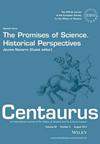流行病结局的多重时间性
IF 0.5
1区 哲学
Q3 HISTORY & PHILOSOPHY OF SCIENCE
引用次数: 0
摘要
流行病的开始往往被告知,就好像它们很容易及时定位一样。它们采取危机的形式,因此,作为不同时间性的伟大同步器,使社会时间性与生物时间性“一致”。例如,在新冠肺炎大流行的情况下,通常缓慢的政治进程被加速,以“赶上”病毒繁殖的快速步伐,因为政策制定者认为有必要遏制病毒。另一方面,流行病的结束更难确定。这可以归因于这样一个事实,即参与流行病并受其影响的无数行动者在不同的时间尺度上运作。尽管从一开始似乎是同步的,但随着疫情的发展,这些生命变得不同步了。流行病爆发的一些影响很容易观察到,例如感染率和死亡人数。其他心理或医学后遗症,或人群中的持久记忆可能更难发现。宣布流行病已经“结束”通常取决于前者的停止,而不是后者。然而,正如这篇文章所说,流行病的结束应该被视为复数,每个结束都有自己的节奏和规模。本文探讨了流行病涉及的生命周期的多样性——人类、微生物、机构,并试图用多重时间性的方法解释流行病是如何结束(或持续)的。本文章由计算机程序翻译,如有差异,请以英文原文为准。
The Multiple Temporalities of Epidemic Endings
The beginnings of epidemics are often told as if they are simple to locate in time. They take the form of a crisis, and as such, function as great synchronisers of different temporalities, bringing social temporalities "in line" with biological ones. In the case of the COVID-19 pandemic, for example, political processes that are usually slow were accelerated in order to "catch up with" the fast pace of the virus's reproduction, as policymakers saw a need to contain the virus. The end of an epidemic, on the other hand, is more difficult to pinpoint. This can be attributed to the fact that the myriad actors involved in and affected by an epidemic operate on diverging time scales. Although seemingly synchronised from its outset, these lifetimes become unsynchronised as the epidemic unfolds. Some effects of an epidemic outbreak are easily observed, such as infection rates and the number of deceased. Others-psychological or medical aftereffects, or the lasting memory in a population-may be harder to spot. Declaring that an epidemic has "ended" usually relies on the ceasing of the former, not the latter. However, as this article argues, the ending(s) of an epidemic should be regarded in the plural, each operating within its own rhythm and scale. This article explores the multiplicity of lifetimes involved in epidemics-human, microbial, institutional-and tries to give an explanation as to how epidemics end (or linger on) using an approach of multiple temporalities.
求助全文
通过发布文献求助,成功后即可免费获取论文全文。
去求助
来源期刊

Centaurus
HISTORY & PHILOSOPHY OF SCIENCE-
CiteScore
3.10
自引率
25.00%
发文量
52
审稿时长
>12 weeks
期刊介绍:
Centaurus publishes an international spectrum of original research papers, historiographical articles, and other academic content on the history of science in the broadest sense, including mathematics, medicine, biomedical sciences, earth sciences, social sciences, humanities and technology, and their social and cultural aspects. We also invite contributions that build a bridge between history of science and other disciplines. Book notices, book reviews and essay reviews of publications within the journal''s scope are commissioned to experts. The Editor encourages suggestions for special issues, short papers on topics of current interest and articles suited to open peer commentary along with a list of potential commentators.
 求助内容:
求助内容: 应助结果提醒方式:
应助结果提醒方式:


